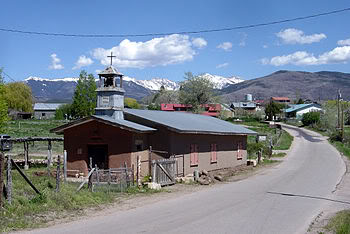New Mexico: Ground Zero for Medicaid Expansion in Rural Areas

(Photo courtesy of the Rio Arriba Community Health Council blog.)
Ever since New Mexico Governor Susana Martinez said she would support making Medicaid accessible to more uninsured New Mexicans, healthcare workers and advocates working in communities around the state have been identifying ways in which they may link the uninsured with new coverage opportunities available through the Affordable Care Act (health reform) in 2014 and likely Medicaid.
The Governor’s announcement presents some unique opportunities for expanded healthcare coverage in the state, but also challenges. While the state boasts a relatively small population – around 2 million – it also has one of the largest uninsured rates in the country. It also has many hard-to-reach, rural areas and a large population that knows little or nothing about the positive health coverage changes upon them.
"Word of mouth will be critical in letting people know about the Medicaid expansion," said Quela Robinson, staff attorney at the New Mexico Center on Law and Poverty. “Reaching out to these communities is going to be really important. We want to make sure we are giving people information in a format that is relevant to them from sources that they trust.”
Most recently, the New Mexico Center on Law and Poverty, Kids Well and New America Media held a roundtable discussion in Albuquerque with members of the ethnic media to tackle exactly that: how does one spread the word, and in a culturally relevant manner, to rural, hard-to-reach places? Here were some of the challenges that the panelists, including Robinson, agreed on:
• In a state that is only 2.5 percent African American, African American voices are often lacking in health care discussions even though the community stands to gain from the Medicaid expansion.
• New Mexico has already expanded Medicaid coverage for children to 235% federal poverty level. A family of four making up to $54,000 a year could attain healthcare coverage for their children right now, yet a lot of parents don’t know about it. “Most of these children who are eligible but are not enrolled are in the Four Corners area and in the Doña Ana County,” Robinson said.
• Health care coverage for the Native American Navajo Nation is neither comprehensive nor accessible, according to another panelist, Sovereign Hager, staff attorney at DNA-People’s Legal Services. “With the Medicaid expansion, the real challenge in Indian Country, in particular in the Four Corners area of Navajo Nation, is getting the information out there to people living very remotely from not only healthcare services but many services,” she said.
One very rural, Hispanic-dominant area near the Four Corners region is Rio Arriba, New Mexico. The county has already leveraged the Affordable Care Act to focus its dollars on preventative care in hard-to-reach communities.
In 2010, the county turned around its dismal record of vaccinating senior citizens from eight to over 2,000, according to Rio Arriba County Health & Human Services director Lauren Reichelt.
Reichelt, who made the tail end of the Albuquerque panel discussion, shared this on the MomsRising blog:
The county approached the hospital with a novel proposition. If, instead of putting budget into billboards, Española Presbyterian Hospital would send staff nurses to immunization fairs at Rio Arriba’s nine senior centers, County officials would conduct an intensive education campaign letting residents (and especially seniors) know about Española Hospital’s excellent safety and health outcomes, which exceed neighboring hospitals, even in wealthy Los Alamos and Santa Fe.
Senior citizens flocked to the fairs. Rio Arriba County and our partners administered over 2,000 vaccines, increasing senior vaccination rates by an incredible 28,000%. Rio Arriba moved in a few weeks, from last among the 33 New Mexico Counties to either second or first.
As communities across the country parse through the ACA and implement the law, New Mexico could serve as a model of how to expand coverage in diverse and hard-to-reach places.

The views and opinions expressed in this post are those of the author(s) and do not necessarily reflect those of MomsRising.org.
MomsRising.org strongly encourages our readers to post comments in response to blog posts. We value diversity of opinions and perspectives. Our goals for this space are to be educational, thought-provoking, and respectful. So we actively moderate comments and we reserve the right to edit or remove comments that undermine these goals. Thanks!